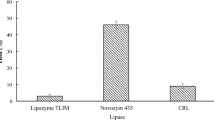Abstract
Because of the increasing concern about the potential risks to human health presented by phthalate esters and, in particular, di(2-ethylhexyl)phthalate the development of non-toxic, environmentally-friendly plasticizers is rather urgent. Biobased materials derived from an annually renewable source are particularly attractive in this regard. A series of esters/ethers generated from tartaric acid, an edible, renewable by-product of wine-making, has been synthesized and fully characterized using chromatographic, spectroscopic and thermal methods. The thermal degradation characteristics of these compounds have been established using thermogravimetry and infrared spectroscopy. These materials are stable to temperatures approaching 200 °C and degrade via elimination processes. They should function as effective plasticizers for a variety of polymeric materials including poly(vinyl chloride).













Similar content being viewed by others
References
Chen G-Q, Patel MK. Plastics derived from biological sources: present and future: a technical and environmental review. Chem Rev. 2012;112:2082–99.
Ravichandran S, Nagarajan S, Ku BC, Coughlin B, Emrick T, Kumar J, Nagarajan R. Halogen-free ultra-high flame retardant polymers through enzyme catalysis. Green Chem. 2012;14:819–24.
Rahman M, Brazel CS. The plasticizer market: an assessment of traditional plasticizers and research trends to meet new challenges. Prog Polym Sci. 2004;29:1223–48.
Arendt WD, MaBride EL, Hanes RD. New dibenzoate plasticizer blends for pvc applications. J Vinyl Addit Technol. 2014;20:134–42.
Gil N, Saska M, Negulescu I. Evaluation of the effects of biobased plasticizers on the thermal and mechanical properties of poly(vinyl chloride). J Appl Polym Sci. 2006;102:1366–73.
Calo E, Greco A, Maffezzoli A. Effects of diffusion of a naturally-derived plasticizer for soft PVC. Polym Degrad Stab. 2011;96:784–9.
Bouchareb B, Benaniba MT. Effects of epoxidized sunflower oil on the mechanical and dynamical analysis of plasticized poly(vinyl chloride). J Appl Polym Sci. 2008;107:3442–50.
Wypych G. Handbook of plasticizers. Toronto, ON: ChemTec Publishing; 2012.
Gachter R, Muller H. Plastics additives handbook: stabilizers, fillers, reinforcements, colorants for thermoplastics. 4th ed. Munich: Hanser Publishers/Oxford University Press; 2003.
Lutz JT. Thermoplastic polymer additives: theory and practice. New York: Marcel Dekker Inc; 1989.
Mohsin M, Hossin A, Haik Y. Thermomechanical properties of poly(vinyl alcohol) plasticized with varying ratios of sorbitol. Mater Sci Eng A. 2011;528:925–30.
Zoller A, Marcilla A. Soft PVC foams: study of the gelation, fusion, and foaming processes. I. phthalate ester plasticizers. J Appl Polym Sci. 2011;121:1495–505.
De Anda R, Fillot LA, Rossi S, Long D, Sotta P. Influence of the sorption of polar and non-polar solvents on the glass transition temperature of polyamide 6,6 amorphous phase. Polym Eng Sci. 2011;51:2129–35.
Ambrogi V, Brostow W, Carfagna C, Pannico M, Persico P. Plasticizer migration from cross-linked flexible PVC: effects on tribology and hardness. Polym Eng Sci. 2012;52:211–7.
Navarro R, Perrino MP, Tardajos MG, Reinecke H. Phthalate plasticizers covalently bound to PVC: plasticization with suppressed migration. Macromolecules. 2010;43:2377–81.
Lorz PM, Towae FK, Enke W. Phthalic acid derivatives, Ullmann’s encyclopedia of industrial chemistry. Weinheim: Wiley-VCH; 2002.
Tickner JA, Schettler T, Guidotti T, McCally M, Rossi M. Health risks posed by use of di-(2-ethylhexyl)phthalate (DEHP) in PVC medical devices: a critical review. Am J Ind Med. 2001;39:100–11.
Crespo J, Balart R, Sanchez I, Lopez J. Substitution of di-(2-ethylhexyl)phthalate by Di(isononyl) cyclohexane-1,2-dicarboxylate as a plasticizer for industrial vinyl plastisol formulations. J Appl Polym Sci. 2007;104:1215–20.
Zhou J, Ritter H. Copolyesters as non-toxic plasticizers. Polym Int. 2011;60:1158–61.
VanVlict EDS, Reitano EM, Chhabra JS, Bergen GP, Whyatt RM. A review of alternatives to di-(2-ethylhexyl)phthalate-containing medical devices in the neonatal intensive care unit. J Perinatol. 2011;31:551–60.
Newman MS, Sujeeth PK. Conversion of aromatic and α, β- unsaturated aldehydes to dichlorides by thionyl chloride and dimethylformamide. J Org Chem. 1978;43:4367–9.
Montalbetti AGN, Falque V. Amide bond formation and peptide coupling. Tetrahedron. 2005;61:10827–52.
Yuan HS, Huang ZT. Synthesis of chiral calix[4]arenes bearing tartaric ester moieties. Tetrahedron Asymmetry. 1999;10:429–37.
Zhou X, Liu W-J, Ye J-L, Huang P-Q. A versatile approach to pyrrolidine azasugars and homoazasugars based on a highly diastereoselective reductive benzyloxymethylation of protected tartarimide. Tetrahedron. 2007;63:6346–57.
Demirbas A. Progress and recent trends in biodiesel fuels. Energy Convers Manage. 2009;50:14–34.
Lima G, Soares VCD, Ribeiro EB, Carvalho DA, Cardoso ECV, Rassi FC, Mundim KC, Rubim JC, Suarez PAZ. Diesel-like fuel obtained by pyrolysis of vegetable oils. J Anal Appl Pyrolysis. 2004;71:987–96.
Author information
Authors and Affiliations
Corresponding author
Rights and permissions
About this article
Cite this article
Howell, B.A., Sun, W. Thermal degradation of esters/ethers derived from tartaric acid. J Therm Anal Calorim 122, 1167–1175 (2015). https://doi.org/10.1007/s10973-015-4934-0
Received:
Accepted:
Published:
Issue Date:
DOI: https://doi.org/10.1007/s10973-015-4934-0




